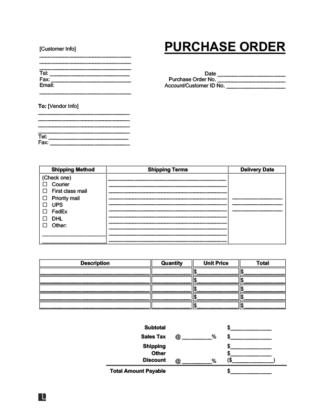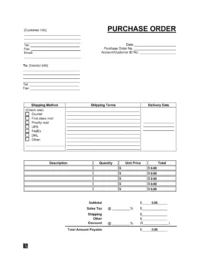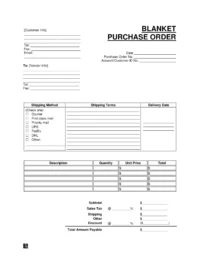
Use our Purchase Order Template to record details of goods purchased.

Updated July 7, 2023
Written by Yassin Qanbar | Reviewed by Brooke Davis
A purchase order is a commercial document issued by a buyer to a seller authorizing the purchase of specific goods or services, and it can be used as a legally binding agreement to ensure the terms of a transaction are met and provide a detailed record for auditing and financial management.
Like an online shopping cart, a PO aids both parties in recording transactions and outlining order specifics, payment terms, and delivery details.

Use this template to record details of goods purchased.

Use this template to facilitate payments made by a business for the same services and commodities.
Planned Purchase Order: A planned purchase order, or PPO, is a long-term purchase order that commits to buying items or services from a single source.
Contract Purchase Order: This is a skeleton purchase order that only includes negotiated terms and conditions between a business and the supplier. A contract order states more purchase orders will be required in the future and establishes guidelines for those orders.
A purchase order is a written document that records a business transaction between two parties – the Buyer and Seller. An order is issued by the Buyer when large purchases are made.
Once a Seller accepts the order, a legally binding contract is formed between the Buyer and Seller.
A purchase order is different from a purchase agreement.
As a reference, this document and the parties involved are known by several names:
| Purchase Order | Buyer | Seller |
|---|---|---|
| “PO” abbreviation | Vendee | Vendor |
| Contract Purchase Agreement | Purchaser | Supplier |
| Customer |
Below you can find the advantages and disadvantages of purchase orders:
A Buyer sends a Purchase Order BEFORE payment is made to request the Seller deliver a certain number of goods officially. In contrast, a Seller sends an invoice AFTER placing an order and demands payment for the goods purchased.
Alternatively, an Invoice is used as a receipt when the Buyer has paid for the goods ordered.
There are several significant benefits of a purchase order. They include:
With purchase orders, there is a paper trail of all prior orders. This makes it easier for companies to go back and audit their previous purchases to see how much money was spent and where it was spent.
Having purchase orders also makes it easier to track expenses. Purchase orders should have numbers so they can be placed in order. Then, companies can go back and tabulate their costs down the line.
Without purchase orders, it will be harder for companies to invoice correctly. With a paper trail for purchase orders, it is easier for companies and suppliers to generate and check the accuracy of invoices.
Without a paper trail, information can get lost in the process. Businesses and suppliers must provide transparency regarding operations, and with numbers printed on a purchase order, there will be no confusion.
Legal protection is also essential when generating purchase orders. Like most business contracts, a legally binding contract is implemented when purchase orders are generated correctly.
This is important for protecting the supplier and the business making the purchase.
It also helps with risk mitigation, minimizing procurement risks.
Several elements need to be included in a purchase order. They include:
The contact information for the supplier and the business purchasing should be included. Some contact information must be mentioned, including each company’s name, email, phone number, and physical address.
The contact information is critical if there is a question about the order or if something changes down the line.
The business and vendor will need to track their purchase orders. These orders should be tracked using a centralized computer system, and it is easier to follow these orders when they have an assigned number.
It might be easier if both the business and the vendor use the same purchase order number, so make sure it is printed clearly on the page.
Some orders, such as orders involving raw materials, also need to include individual SKU numbers. This ensures the correct items are picked out, packaged, and invoiced easier.
These numbers can also be used to cross-check things to ensure they are received appropriately.
On the purchase order, the price for each item should be included. Ideally, the price should be for a single product. Then, there should be a separate column for the quantity of each item that has been ordered.
Across one row, the price and number of each item should be easy to multiply, leading to a final price for each category.
It might also be helpful to include a brief description of each item. This is particularly important if the same item is available in different sizes. This makes it easier for the vendor and business to ensure they are ordering and delivering the right products.
The order total should be printed at the bottom of the page. Generally, it is in the right-hand corner, but the most important thing is that the order total has to be in the same spot every time. Do not forget to list any price adjustments that might be present.
For example, the business might be responsible for paying a sales tax on the order, and the tax should be in a specific location before it is rolled into the final price.
If there are any sales, promotions, or discounts that are applied to the order, these should be placed in a separate category. Then, specify how these adjustments are calculated before the final price is printed on the purchase order.
The payment terms should be negotiated between the business and the vendor beforehand. Be sure to print the due date on the order.
Using a purchase order template ensures all of the above will be included, and you need to fill in the blanks.
Below are the steps for creating and using purchase orders in your business.
This first step depends on the size and structure of the company. In some businesses, departments or managers need approval from another department, like accounting or finance, before purchasing.
This step allows the company to maintain some control and budgetary discretion over purchases.
Once you receive approval, it’s time to create the purchase order. A purchase order should include a detailed list of purchased goods or services. The document confirms what you ordered, so it’s essential to ensure the list of goods and services is correct before sending it to the vendor.
Use a purchase order template to ensure you include all the essential information.
The purchase order should also include a purchase order number. This will help you track it through the process and the invoicing system.
Once the purchase order is ready, please send it to the vendor. This is their indication that you are prepared to purchase their goods or services.
After the vendor receives the purchase order, they should acknowledge the receipt (a bill of sale could be used instead, which can include more purchase details). Once this happens, the purchase is binding.
Barring any extraordinary situations, the vendor owes you the goods and services, and you owe them the money.
At this point, the process is in the hands of the vendor. It is now their job to deliver the goods and services specified in the purchase order. This should happen promptly. If it doesn’t, you may be able to pull the purchase order.
The final step is to match the goods and services delivered with the purchase order and the invoice. Everything should align to ensure you only pay for your ordered goods and services. If everything is in alignment, it’s time to pay the invoice.
When filling out a Purchase Order, you should keep in mind the following tips:
This document is commonly used in business and commercial transactions for more sophisticated transactions. If you are buying many products or types of products, you should use them to document what is being purchased for your business formally.
Because these are legally binding contracts, Buyers can create a formal paper trail of items purchased for their business. Official records help bookkeepers and accountants keep track of inventory, orders placed, and items received.
A PO is a written authorization from a Buyer to acquire many goods or services. The Seller is then legally obligated to deliver such goods and services.
You should use one if one of the following situations apply:
For example, a Buyer may want to:
Purchase Orders are not only used by large US government agencies like the Department of Energy (DOE) or the US Department of Defense (DoD). Even if you are a one-person business, this helps you track what has been ordered, shipped, and paid for.
Below, we offer a free Purchase Order template to record a transaction between a buyer and a seller. You can download the document in PDF and Word: